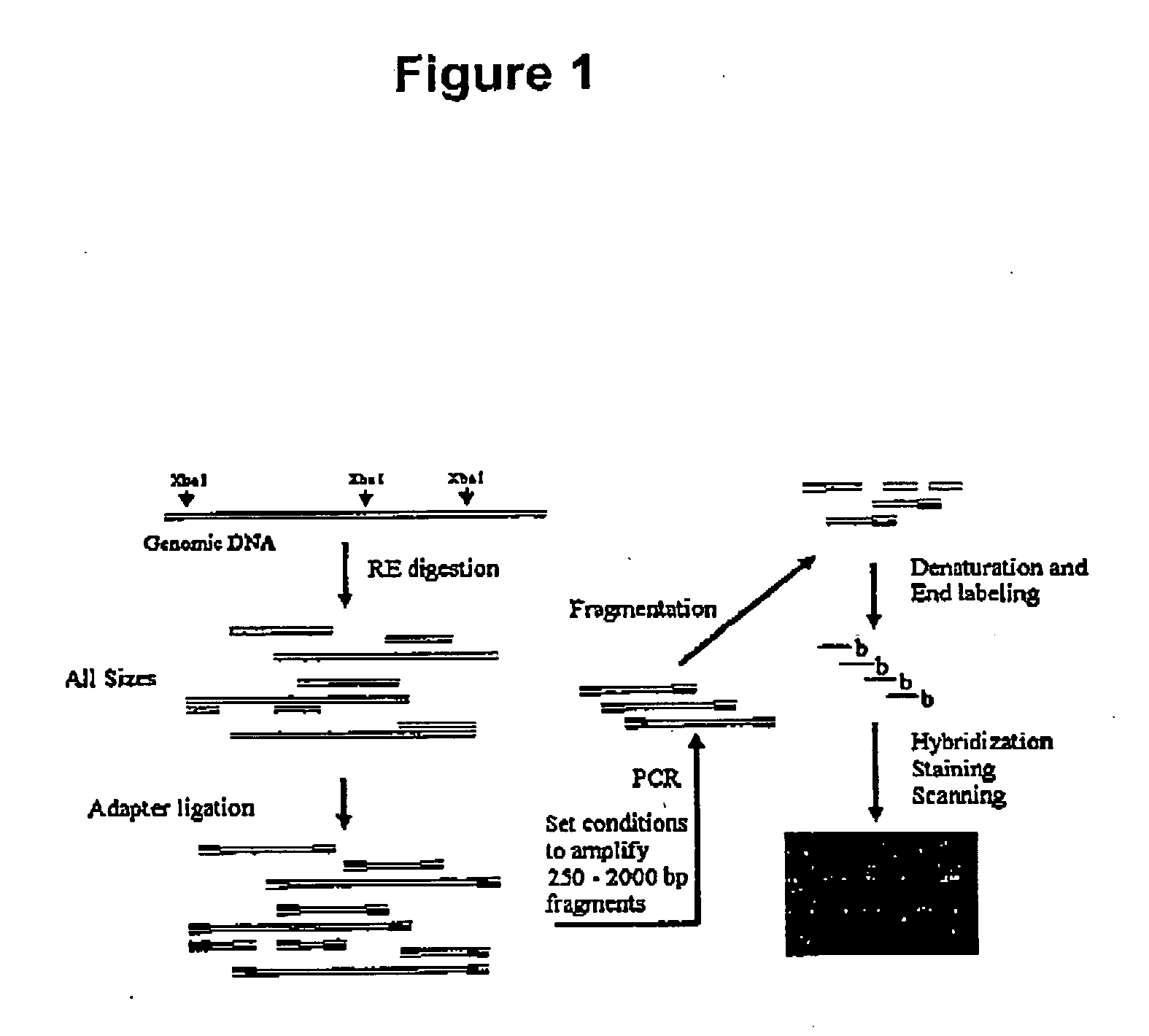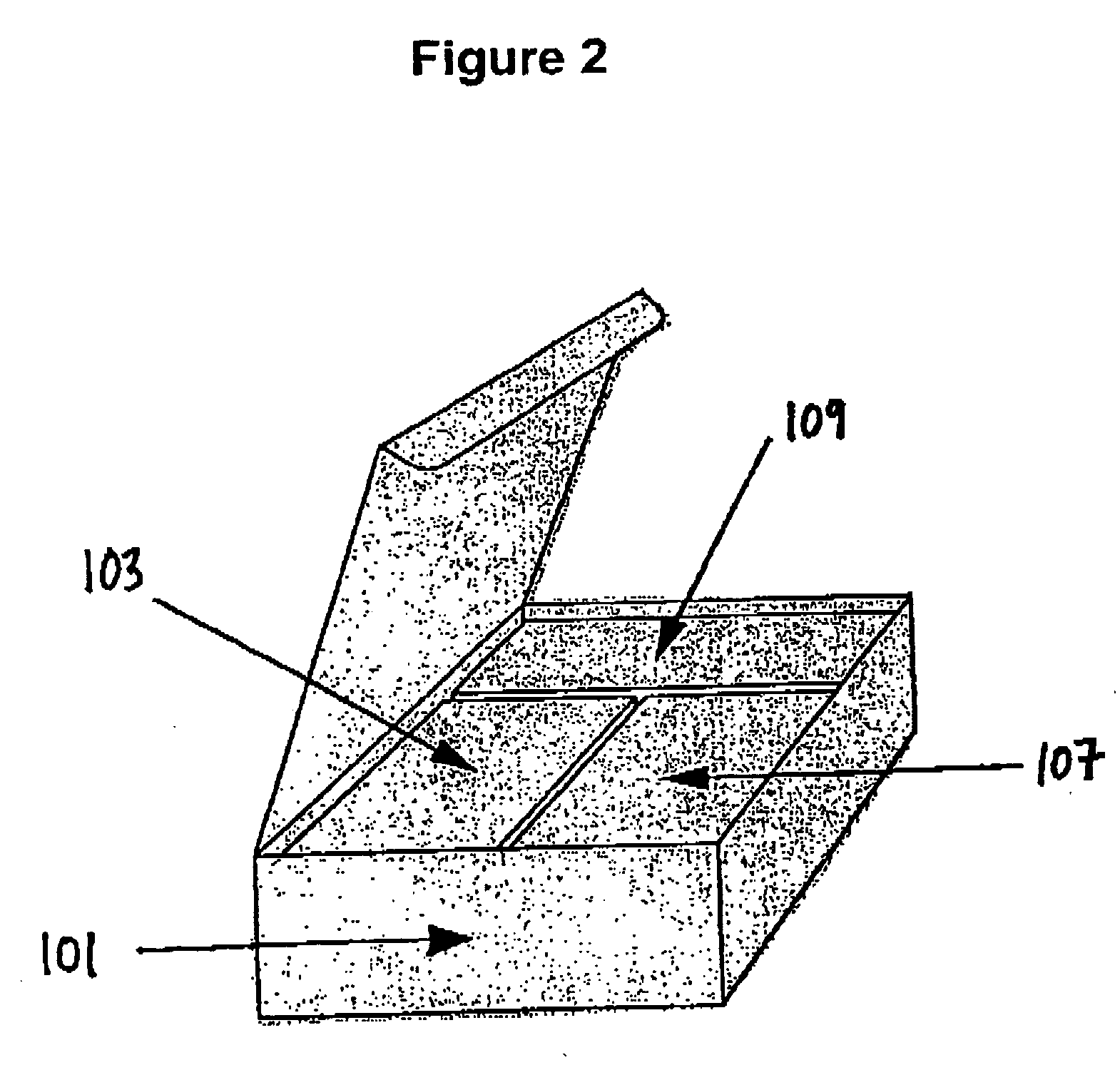Genotyping methods
a technology of gene expression and gene expression, applied in the field of molecular biology and genetics, can solve problems such as tensile complexity of genomes, and achieve the effect of reducing the chance of contamination of reagent stocks
- Summary
- Abstract
- Description
- Claims
- Application Information
AI Technical Summary
Benefits of technology
Problems solved by technology
Method used
Image
Examples
example 1
[0117] Preparation of Genomic DNA. Determine the concentration of the genomic DNA and dilute the working stocks to 50 ng / μL using reduced EDTA TE buffer (0.1 mM EDTA, 10 mM Tris HCl, pH 8.0). For high throughput assays, aliquot 5 μL (50 ng / μL) of each diluted genomic DNA into each well of a 96-well plate. Make multiple replicates of the plates if needed.
[0118] Reagent Preparation and Storage. Store the reagents necessary for the restriction digestion, ligation and PCR steps should in the pre-PCR clean room (or area for the DNA template and free of PCR products) to minimize cross contamination between samples. To avoid re-entering the pre-PCR clean room after entering the PCR-Staging Room or the Main Lab, aliquot each of the reagents in the pre-PCR clean room before starting the rest of the experiment.
[0119] Restriction enzyme digestion of unamplified genomic DNA samples. In the pre-PCR clean area, prepare the following Digestion Master Mix ON ICE (for multiple samples make a 5% ex...
example 2
[0137] High throughput preparation of reduced complexity samples. To increase sample throughputs, procedures were carried out in 96-well plates. For each individual assayed, 250 ng of genomic DNA was digested with 10 U of Xba I (New England BioLabs) in a volume of 15 μL for 2 hours at 37° C. Following heat inactivation at 70° C. for 20 minutes, 0.25 μM of adaptor (5′phosphate-CTA GAG ATC AGG CGT CTG TCG TGC TCA TAA-3′ (SEQ ID NO 1), and 5′-ATT ATG AGC ACG ACA GAC GCC TGA TCT-3′ (SEQ ID NO 2)) was ligated to the digested DNA with T4 DNA Ligase (New England BioLabs) in 25 μL for 2 hours at 16° C. The ligation was stopped by heating to 70° C. for 20 minutes, and then diluted 4-fold with water. For each sample, four PCRs were run using 10 μL of the diluted ligation reaction (25 ng of starting DNA) in 100 μL volumes containing 0.75 μM of primer (sense strand of adaptor), 0.25 mM dNTPs, 2.5 mM MgCl2, 10 U AmpliTaq Gold® (Applied Biosystems), and PCR Buffer (Applied Biosystems). 35 cycles ...
example 3
[0138] Workflow for GeneChip High Throughput 10K Mapping Assay. Phase 1 is sample preparation for 1400 individual samples to be performed in 10 days. The lab setup is as follows: 8 96 well heating blocks capable of thermal cycling placed in low template room, 12 96 well PCR modules, 8 Qiagen QiaVac and MinElute plates for purification, a plate reader for DNA quantification, one 12 channel pipettes and two repeating pipettes.
[0139] During week 1 samples are prepared for 768 samples. Start with 50 ng / μl genomic DNA working stocks in 8 96 well plates. The genomic DNAs are in water. Week 2 is used to prepare samples from an additional 768 samples using the protocol for week 1. During weeks 3 and 4 each sample is hybridized to one copy of a genotyping array. Table 1 shows a workflow for a high throughput 10K Mapping Assay. FTE is full time employee and is an indication of how many employee resource hours are used.
TABLE 1Day 1Restriction enzyme digestion and ligation 9:00 amThaw 8 plat...
PUM
| Property | Measurement | Unit |
|---|---|---|
| temperature | aaaaa | aaaaa |
| temperature | aaaaa | aaaaa |
| temperature | aaaaa | aaaaa |
Abstract
Description
Claims
Application Information
 Login to View More
Login to View More - R&D
- Intellectual Property
- Life Sciences
- Materials
- Tech Scout
- Unparalleled Data Quality
- Higher Quality Content
- 60% Fewer Hallucinations
Browse by: Latest US Patents, China's latest patents, Technical Efficacy Thesaurus, Application Domain, Technology Topic, Popular Technical Reports.
© 2025 PatSnap. All rights reserved.Legal|Privacy policy|Modern Slavery Act Transparency Statement|Sitemap|About US| Contact US: help@patsnap.com


